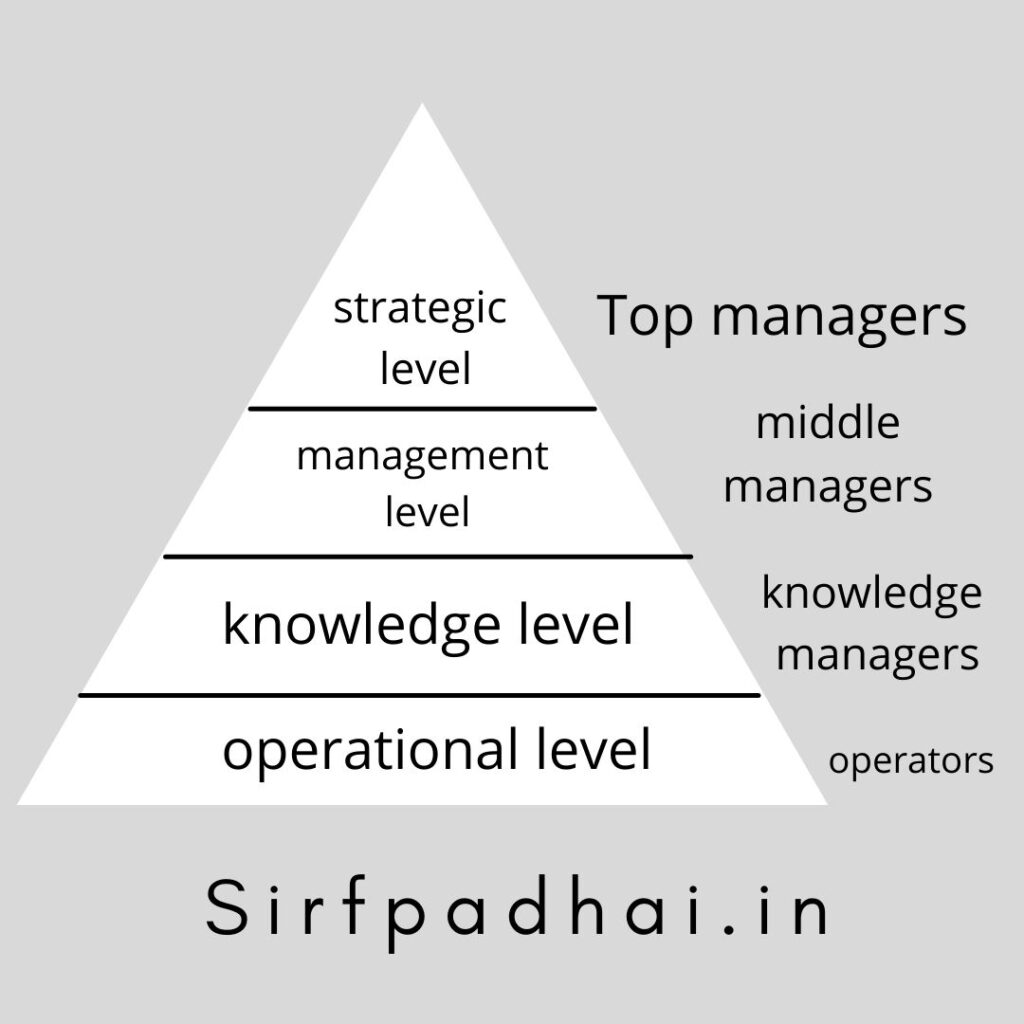information and knowledge management
Data is a collection of raw facts and figures. Whereas information is the result of data processing which can be used to help people in decision making. But knowledge is a collection of interesting and useful information.
In data, there is no role of information whereas in information processing data is the most important element. In the case of knowledge, information is the main element.
types of information systems
CLASSIFICATION AND TYPES OF INFORMATION SYSTEM
There are four levels in any organization – operational level, knowledge level, management level, and strategic level.
The need for information is different for each level. There are many information systems for all the levels which support each level.

There are the following 7 types of information systems:-
The transaction processing system(TPS)
- What is TPS, it processes the transaction and produces the reports.
- That is, TPS collects, processes, stores, modifies, and cancels transactions.
All the transactions that take place in an organization are recorded and processed daily by TPS.
It is used by the users at the operational level.
Many transactions can also be processed simultaneously through TPS.
Whatever data is collected by these systems is stored in the database and this data is processed and used to produce reports. Such as billing, wages (salaries), inventory summary and check registers, etc.
There are many TPS in an organization like:-
- Billing systems for sending invoices to customers
- System for calculating weekly and monthly payroll and taxes.
- Production system to calculate raw material.
The main purpose of the transaction processing system is to answer the questions asked daily like:-
- How many products were sold today?
- How many products are left in stock now?
- What is the discount on which product?
TPS records daily transactions and answers the above questions accordingly.
Management information system(MIS)
Management Information System (MIS) is an information system that processes data and converts it into information. MIS is used by tactical managers to monitor the current performance of the organization.
The output of the transaction processing system (TPS) is like the input for MIS. The MIS system provides reports by comparing and analyzing this input through algorithms. These reports are used by tactical managers to monitor current performance and predict future performance.
MIS is, it provides analysis, planning, and decision-making support.
Decision support system(DSS)
A decision support system (DSS) is used by senior management to make decisions.
What is DSS, it takes input from TPS and MIS.
DSS is used to solve problems. It uses such tools and techniques that collect the necessary information and find solutions based on that information.
The main applications of DSS are production, finance, and marketing.
DSS is different from MIS, MIS converts data into information while DSS uses this information to make decisions.
Executive support system (ESS)
An executive support system (ESS) is used by senior management to make important decisions.
This is a special type of DSS.
ESS collects, analyzes, and summarizes the information. There are many data analysis and modeling tools in this which help a lot in decision making.
Office automation systems (OAS)
Office automation systems (OAS) are used to improve the productivity of employees. It provides secretarial assistance and better communication services to the employees.
The activities of any office can be divided into two parts:-
1) Such activities are completed by clerical employees (clerk, typist, operator, etc.).
2) Such activities are carried out by executives (managers, engineers, etc.).
business expert systems (BES) and neutral systems
Business expert systems (BES) are also called knowledge-based systems.
These systems are based on artificial intelligence and they are very advanced. BES systems analyze the data and provide recommendations and decisions.
The neutral system uses the computer in such a way that the human brain processes information, learns and remembers information.
knowledge management system (KMS)
The knowledge management system (KMS) is used by the organization to create and share information.
It is used by employees to create new knowledge.
To share this knowledge, KMS uses intranet and other collaboration systems.
Request:- If this post on types of information systems has been helpful for you, then share it with your friends, thank you.








